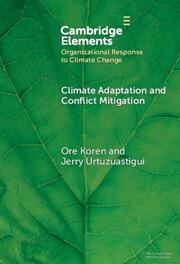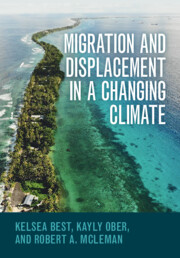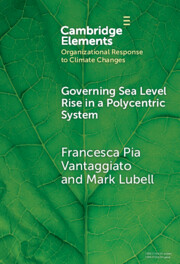Refine search
Actions for selected content:
38 results
6 - Heat, Health, and Hunger
-
- Book:
- From Crisis to Action
- Published online:
- 15 August 2025
- Print publication:
- 04 September 2025, pp 111-142
-
- Chapter
-
- You have access
- Open access
- HTML
- Export citation
An integrated view on the uncertainties of sea-level rise, hazards and impacts, and adaptation
-
- Journal:
- Cambridge Prisms: Coastal Futures / Volume 3 / 2025
- Published online by Cambridge University Press:
- 16 June 2025, e13
-
- Article
-
- You have access
- Open access
- HTML
- Export citation
A policy analysis of low carbon development in the context of the water-energy-food nexus: Examining the low emission development strategy in Fiji
-
- Journal:
- Cambridge Prisms: Water / Volume 3 / 2025
- Published online by Cambridge University Press:
- 27 May 2025, e8
-
- Article
-
- You have access
- Open access
- HTML
- Export citation

Climate Adaptation and Conflict Mitigation
- The Case of South Sudan
-
- Published online:
- 21 April 2025
- Print publication:
- 12 June 2025
-
- Element
- Export citation
1 - People on the Move in a Changing Climate
-
- Book:
- Migration and Displacement in a Changing Climate
- Published online:
- 10 April 2025
- Print publication:
- 17 April 2025, pp 1-50
-
- Chapter
- Export citation
Climate Futures at Play: Performing Environmental Public Humanities
- Part of
-
- Journal:
- Public Humanities / Volume 1 / 2025
- Published online by Cambridge University Press:
- 15 April 2025, e87
-
- Article
-
- You have access
- Open access
- HTML
- Export citation
Monitoring climate change impacts, Indigenous livelihoods and adaptation: Perspectives from Inuit community of Hopedale, Nunatsiavut, Canada
-
- Journal:
- Cambridge Prisms: Coastal Futures / Volume 3 / 2025
- Published online by Cambridge University Press:
- 14 April 2025, e10
-
- Article
-
- You have access
- Open access
- HTML
- Export citation

Migration and Displacement in a Changing Climate
-
- Published online:
- 10 April 2025
- Print publication:
- 17 April 2025
Balancing conservation and human access to nature: the impact of a constructed causeway on water levels and sedimentation, North Bull Island, Ireland
-
- Journal:
- Cambridge Prisms: Coastal Futures / Volume 3 / 2025
- Published online by Cambridge University Press:
- 04 April 2025, e9
-
- Article
-
- You have access
- Open access
- HTML
- Export citation
Playing to Survive: Children and Innovation During the Little Ice Age in Greenland
-
- Journal:
- European Journal of Archaeology / Volume 28 / Issue 1 / February 2025
- Published online by Cambridge University Press:
- 29 October 2024, pp. 81-100
-
- Article
-
- You have access
- Open access
- HTML
- Export citation
Engaging faith for a sustainable urban future
-
- Journal:
- Global Sustainability / Volume 7 / 2024
- Published online by Cambridge University Press:
- 10 October 2024, e45
-
- Article
-
- You have access
- Open access
- HTML
- Export citation
Law, Colonial-Capitalist Floods, and the Production of Injustices in Eastern India: Insights for Climate Adaptation
-
- Journal:
- Transnational Environmental Law / Volume 13 / Issue 2 / July 2024
- Published online by Cambridge University Press:
- 07 May 2024, pp. 264-285
-
- Article
-
- You have access
- Open access
- HTML
- Export citation

Governing Sea Level Rise in a Polycentric System
- Easier Said than Done
-
- Published online:
- 30 March 2024
- Print publication:
- 25 April 2024
-
- Element
- Export citation
5 - Moving beyond Mandates
-
-
- Book:
- International Public Administrations in Environmental Governance
- Published online:
- 22 February 2024
- Print publication:
- 29 February 2024, pp 107-130
-
- Chapter
-
- You have access
- Open access
- HTML
- Export citation
1 - Heat
-
- Book:
- Radical Adaptation
- Published online:
- 04 January 2024
- Print publication:
- 18 January 2024, pp 14-51
-
- Chapter
- Export citation
4 - Retreat
-
- Book:
- Radical Adaptation
- Published online:
- 04 January 2024
- Print publication:
- 18 January 2024, pp 104-130
-
- Chapter
- Export citation
Prologue: Dead Pool
-
- Book:
- Radical Adaptation
- Published online:
- 04 January 2024
- Print publication:
- 18 January 2024, pp 1-13
-
- Chapter
- Export citation
3 - Water (Too Little)
-
- Book:
- Radical Adaptation
- Published online:
- 04 January 2024
- Print publication:
- 18 January 2024, pp 81-103
-
- Chapter
- Export citation
Postscript: Vine City
-
- Book:
- Radical Adaptation
- Published online:
- 04 January 2024
- Print publication:
- 18 January 2024, pp 131-137
-
- Chapter
- Export citation
2 - Water (Too Much)
-
- Book:
- Radical Adaptation
- Published online:
- 04 January 2024
- Print publication:
- 18 January 2024, pp 52-80
-
- Chapter
- Export citation
